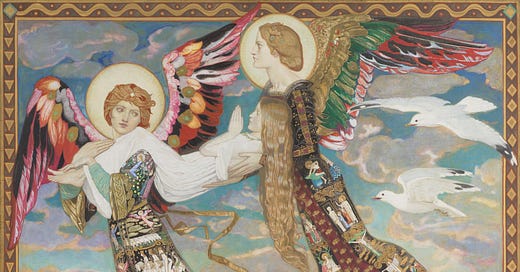Imbolc and the Blessings of Brigid
A few quotations on the Celtic Cross-Quarter Day, Imbolc, and the goddess, Brigid.
“Saint Bride,” John Duncan (1913). Scottish National Gallery.
“According to the legend of the Irish Saint Bride she was transported miraculously to Bethlehem to attend the nativity of Christ. Here two angels carry the white robed saint across the sea. The seascape reflects Duncan's fascination with the Outer Hebrides and the Isle of Iona.”
More info: HERE.
“Brigid was a powerful Celtic god who apparently was born with a flame in her head and drank the milk of a mystical cow from the spirit world”
I love the sentence, above, from this article by Kerry King, “How to celebrate and enjoy Imbolc, the pagan festival marking winter’s end”.
The article continues:
“Over time, she was absorbed by Christianity as St Brigid (one of Ireland’s three patron saints).”
“Imbolc is a pagan holiday celebrated from February 1 through sundown February 2, marking the start of the end of winter, or precisely the halfway point between the winter solstice and the spring equinox.
It forms part of the wiccan Wheel of the Year (the eight sabbats signalling seasonal change) and is also known as Candlemas, Brigids Day, or Divine Spark.
Energetically, from Imbolc onwards, we can take the ideas and insights we received and incubated over winter and start to research and prepare to activate them.
The celebration of Imbolc dates back as far as the 10th century. Ancient celebrations took the form of a festival in honor of the pagan goddess Brigid, who was associated with poetry, crafts and prophecy.”
I think bringing back the Celtic Sacred Calendar, with its cosmological orientation centered on the solstices, equinoxes, and cross-quarter days, is important and timely.
GETTING YOUR IMBOLC ON
“THINGS TO DO AT IMBOLC
This cross-quarter (i.e. mid season) festival is a point when energy changes. We can use this phase to activate a new cycle, bring in new ideas and behaviours.
Try these activities to make the most of the spiritually significant time.
Spring clean and de clutter your home. Open all the windows and sound cleanse each room (by clapping loudly in each corner, or ringing a bell) to shift stagnant energies which have built up over the long winter.
Mood board, journal, prioritise and plan your new activities, ideas and ambitions for the coming year.
Brainstorm with friends, share ideas, create vision boards and goals together.
Collect snowdrops and fresh leaves, twigs of willow, almond and cherry buds. Weave them into a wreath or a circle and place in a window.
Use lots of candles and light fires. Flame is a vital presence in this festival. Fire cleanses and transforms and burns away what you wish to leave behind. Make lists of ~the old~ and burn them. Open the way for new beginnings and growth.
Drum, dance, recite poetry, connect creatively with others, sing songs, join a choir, take a class, paint or draw, plant seeds for new skills and hobbies.”
[from Kerry King’s article, “How to celebrate and enjoy Imbolc, the pagan festival marking winter’s end”.
Below are some quotations from another article, this one from the History Channel, on Imbolc.
The First Keening
“Imbolc is a pagan holiday celebrated from February 1 through sundown February 2. Based on a Celtic tradition, Imbolc was meant to mark the halfway point between the winter solstice and the spring equinox in Neolithic Ireland and Scotland. The holiday is celebrated by Wiccans and other practitioners of neopagan or pagan-influenced religions. Imbolc is just one of several pre-Christian holidays highlighting some aspect of winter and sunlight, and heralding the change of seasons.”
Brigid the Goddess
“Imbolc celebrations took the form of a festival in honor of the pagan goddess Brigid, who was evoked in fertility blessings and oversaw poetry, crafts and prophecy. Brigid was worshipped by the Filid, a class of poets and historians among the Celts of ancient Ireland and Britain.
Brigid was considered one of the most powerful Celtic gods, the daughter of the Dagda, the oldest god in the Celtic pantheon Tuatha du Danann. She had two sisters also named Brigid (though it’s speculated that these sisters are meant to symbolize different aspects of the same goddess.)”
“Myths about Brigid’s birth say she was born with a flame in her head and drank the milk of a mystical cow from the spirit world. Brigid is credited with the very first keening, a traditional wailing for the dead practiced at funerals by Irish and Scottish women.”
“Over the centuries, Brigid was adopted into Christianity as St. Brigid.”
“Brigid (or Bridget) is the patron saint of Irish nuns, newborns, midwives, dairy maids and cattle.”
Whether or not she existed, these stories contain aspects in common with the details of the pagan goddess and illustrate the transition from pagan to Christian worship.
Like the goddess Brigid, St. Brigid is associated with milk and fire.”
[Quotations from this History Channel article on Imbolc.]



